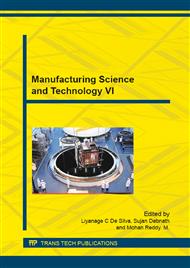[1]
H. Yu, X. Tian, A. Yuan, Green design in low carbon environment, International symposium on water resource and environmental protection, (2011).
DOI: 10.1109/iswrep.2011.5893424
Google Scholar
[2]
G. Weir, T. Muneer, Energy and environmental impact analysis of double glazed windows, in Energy Conversion Management, Vol. 39, No. 3/4, (1998) 243– 256.
DOI: 10.1016/s0196-8904(96)00191-4
Google Scholar
[3]
B. V. V. Reddy, K. S. Jagadish, Embodied energy of common and alternative building materials and technologies, Energy Building, (2003) 35: 129- 137.
DOI: 10.1016/s0378-7788(01)00141-4
Google Scholar
[4]
V. Sugirtha, Low carbon roadmap: guiding our country onto the low-carbon building materials industry, China Construction News, (2010).
Google Scholar
[5]
S. K. Oztas, A model proposal for LCIA for the Turkish building materials sector, PhD thesis, Istanbul Technical University, Turkey (2015).
Google Scholar
[6]
R. Spence, H. Mulligan, Sustainable development and the construction industry, in Habitat International, Vol. 19, No. 3, (1995) 279– 292.
DOI: 10.1016/0197-3975(94)00071-9
Google Scholar
[7]
G. Ding, The development of a multi criteria approach for the measurement of sustainable performance for built projects and facilities, PhD thesis, University of Technology, Sydney, Australia, (2004).
Google Scholar
[8]
S. N. Tucker, M. D. Ambrose, C. Mackley, A 3D model of embodied energy for assessment of sustainable construction, in Proceedings of CIB World Building Congress, Construction and the Environment, Sweden, 7–12 June, (1998)1919– (1926).
Google Scholar
[9]
S. Pullen, Energy used in the construction and operation of houses, in Architectural Science Review, Vol. 43, No. 2, June, (2000) 87– 94.
DOI: 10.1080/00038628.2000.9697439
Google Scholar
[10]
K. Adalberth, Energy use during the life cycle of single-unit dwellings: examples, Building and Environment, Vol. 32, Issue 4, (1997) 321– 329.
DOI: 10.1016/s0360-1323(96)00069-8
Google Scholar
[11]
T. Y. Chen, J. Burnett, C. K. Chau, Analysis of embodied energy use in the residential building of Hong Kong, Energy, (2001) 26: 323- 340.
DOI: 10.1016/s0360-5442(01)00006-8
Google Scholar
[12]
I. Z. Bribian, A. Capilla, A. Uson, Life cycle assessment of building materials: Comparative analysis of energy and environmental impacts and evaluation of the eco-efficiency improvement potential, 2011, Building and Environment 46 (2011).
DOI: 10.1016/j.buildenv.2010.12.002
Google Scholar
[13]
N. Crishna, P. F. G. Banfill, S. Goodsir, Embodied energy and CO2 in UK dimension stone, Resources, Conservation and Recycling 55 (2011) 1265– 1273.
DOI: 10.1016/j.resconrec.2011.06.014
Google Scholar
[14]
S. Maithel, D. Lalchandani, G. Malhotra, P. Bhanware, R. Uma, S. Ragavan, V. Athalye, K. R. Bindiya, S. Reddy, T. Bond, C. Weyant, E. Baum, V. Thoa, N. Phuong, T. Thanh, Brick Kilns Performance Assessment. Shakti Sustainable Energy Foundation and Climate Works Foundation Supported Initiative Report, (2012).
DOI: 10.1016/j.atmosenv.2014.08.075
Google Scholar
[15]
O. Ekincioglu, A. P. Gurgun, Y. Engin, M. Tarhan, S. Kumbaracıbaşı, Approaches for sustainable cement production – A case study from Turkey, Energy and Buildings 66 (2013) 136– 142.
DOI: 10.1016/j.enbuild.2013.07.006
Google Scholar
[16]
C. Koroneos, A. Dompros, Environmental assessment of brick production in Greece, Building and Environment, (2007) 42: 2114– 2123.
DOI: 10.1016/j.buildenv.2006.03.006
Google Scholar


